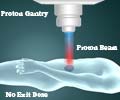A recent study reveals that radiation therapy may soon become more effective with fewer side effects.

"Radiation is a great therapy - the problem is the side effects," said Dr. William S. Dynan, biochemist and Associate Director of Research and Chief, Nanomedicine and Gene Regulation at the GHSU Institute of Molecular Medicine and Genetics.
"We think this is a way to get the same amount of cancer cell death with less radiation or use the same amount and maybe cure a patient that could not be cured before," he stated.
Radiation therapy capitalizes on radiation's ability to kill cells by causing double-strand breaks in DNA. But the fact that varying levels of radiation are essentially everywhere - food, air, the ground, etc. - means all cells, including cancer cells, have internal mechanisms to prevent the lethal breakage.
GHSU scientists are targeting the natural defense mechanisms by packaging a piece of an antibody against one of them with folate, which has easy access to most cells, particularly cancer cells.
Many cancers, including the lung cancer cells they studied, have large numbers of folate receptors so that cancer cells get a disproportionate share of the package.
Advertisement
To get a more direct hit, the scientists took advantage of folate receptors as a point of entry by chemically binding folate with the small piece of their antibody, ScFv 18-2.
Advertisement
"We are joining a targeting molecule with a cargo," said Dynan.
Li added, "This strategy targets one of the key enzymes so it's harder to repair."
This makes cancer cells more vulnerable to radiation.
Dynan and Li say the approach could be used to deliver any number of drugs directly inside cancer cells.
Source-ANI















